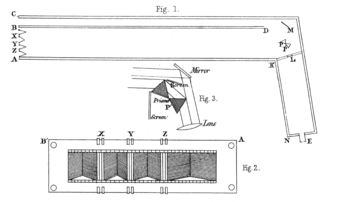User:Jasonmonroe417/sandbox
Little is known about Katherine's personal life. Some insight can be gathered from her husband's correspondence letters preserved by Lewis Campbell. Her hobbies included riding horses and possibly crocheting.
Early Life and Marriage
[edit]Katherine Mary Dewar was born in 1824 In Glasgow,[1][2] the daughter of Susan Place[1] and the Presbyterian Rev. Daniel Dewar,[5] Principal of Marischal College, Aberdeen.[3] Little of her early life appears to be recorded.
When she was in her early thirties Katherine met James Clerk Maxwell (7 years her junior) during his tenure as Professor of Natural Philosophy at Marischal College (1856–1860).[1]
Her father, Rev. Daniel Dewar developed a friendship with James which resulted in his frequent visits to the Dewar household as well as an invitation to join them on a family holiday.[1]
James announced their engagement in February 1858[6] and they were married in the parish of Old Machar, Aberdeen on 2 June 1859.[3][4] The couple never had any children.[7]
Personal life
[edit]After the merger of Marishal College with Kings College to form the new University of Aberdeen in 1860, James Clerk Maxwell lost his position and the couple moved to London for five years whilst Katherine's husband took up the role of Natural Philosophy Chair at King's College. Katherine nursed her husband through smallpox in September 1860 at the Maxwell family estate in Glenlair, then through erysipelas following a riding incident in September 1865.[6]
The Maxwell's were avid riders. In a letter to a friend and colleague, James mentioned their regular outings to the Brig of Urr, mounted on their horses Darling and Charlie.[2] Charlie was a bay pony that James bought for Katherine at a horse fair where James allegedly contracted smallpox.[1] Charlie was named after Charles Hope Cay, the very friend to whom James wrote.
Scientific Contribution
[edit]Before and during their marriage Katherine aided James in his experiments on colour vision and gases.[1][6] Katherine's observations were valuable to James' scientific work. In his publication in the Philosophical Transactions titled On the Theory of Compound Colours, and the Relations of the Colours of the Spectrum, James records the observations of two individuals. He reveals himself as the first observer labeled J, but describes the second individual anonymously as "another observer (K)."[3] Lewis Campbell confirms that the observer K is indeed Katherine.[2]
Colour Vision Experiments
[edit]
The apparatus used in the colour vision experiments is depicted in Fig. 1 shown to the left. It was constructed by joining a 5 foot box (AK) with a 2 foot box (KN) at a 100 degree angle. Light coming through the opening at BC is reflected by a mirror at M towards a lens at L. Two equilateral prisms at P diffract light coming from the three slits at X Y and Z. This illuminated the prisms with the combination of the spectral colors created by the diffraction of the light from the slits. This light was also visible through the lens at L. The observer then peered through the slit at E while the operator adjusted the position and width of each slit at X Y and Z until the observer could not distinguish the prism light from the pure white light reflected by the mirror. The position and width of each slit was then recorded.
James and Katherine performed this experiment in their home. Their neighbors supposedly thought that they were "mad to spend so many hours staring into a coffin."[2] Katherine's observations differed from Jame's on several accounts. James described these differences in section XIII of his publication, noting that there was a "measurable difference" between the colors perceived by each observer.[3] Campbell also sites readings by C. H. Cay to be different from Katherine's, although a third observer is not listed in this particular Philosophical Transactions publication.[2] This led him to develop his theory of colour vision and to discover the (commonly occurring) blindness of the Foramen Centrale to blue light.
Viscosity of Gas Experiments
[edit]Katherine appears to have played a significant role in Clerk Maxwell's experimental research. In a letter to P.G. Tait, James Clerk Maxwell wrote about Katherine's contribution to measurements of gaseous viscosity associated with his paper "On the Dynamical Theory of Gases", saying that Katherine "did all the real work of the kinetic theory" and that she was now "...engaged in other researchers. When she is done I will let you know her answer to your enquiry [about experimental data]".[1][8] Some of the more arduous work performed by Katherine in these experiments involved keeping a fire continuously stoked for hours on end for the purpose of producing steam from a kettle.[2]
A fire at Glenlair destroyed the majority of Maxwell's papers which has made it more difficult for historians to reconstruct further details of Katherine Clerk Maxwell's scientific contribution.[1]
 | This is a user sandbox of Jasonmonroe417. You can use it for testing or practicing edits. This is not the sandbox where you should draft your assigned article for a dashboard.wikiedu.org course. To find the right sandbox for your assignment, visit your Dashboard course page and follow the Sandbox Draft link for your assigned article in the My Articles section. |
References
[edit]- ^ a b Mahon, Basil (2003). The Man Who Changed Everything: The Life of James Clerk Maxwell. John Wiley & Sons Ltd. p. 91. ISBN 0-470-86088-X.
- ^ a b c d e Campbell, Lewis; Garnett, William (1882). The Life of James Clerk Maxwell: With a Selection From His Correspondence and Occasional Writings and a Sketch of His Contributions to Science. London: MacMillan and Co. pp. 231–250.
- ^ a b Maxwell, J. Clerk (1860). "On the Theory of Compound Colours, and the Relations of the Colours of the Spectrum". Philosophical Transactions of the Royal Society. 150: 57–84.
